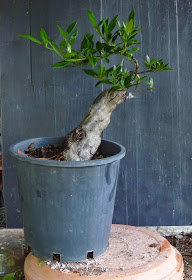Over the last week I finished off a number of pots in two glaze firings. There were a number of large commission pots fired and I'll post these first.
This teal glaze is one I use regularly. It has a little more sheen to it than my regular satin glazes but that will sit well with the type of tree that you would normally place in a pot of this colour.
This one steps up a little in size and with a short axis on about 74% of the long is about where I would normally set the relationship. The objective with this glaze was to get a little of the dapple break but not too much.
Some time ago on my glazing journey I reached a point of resolving how much glaze to put on a pot for a uniform cover and it came to about 450 grams of dry ingredients per square meter of surface area. So if the glaze is brushed or rolled on the number of coats then becomes academic, unless of course some differentiation in the finish is required which can only be achieved through the application. Finishing one pot like another becomes a challenge of glaze application.

Pots 135 and 136
were ordered on the same basis, seeking surface finish replication. I
maintain good records of glazes and their formulation, but variation in
application is more challenging. These two are big pots at the limit of
my kiln space. In fact they have to be placed off square to get them in. The final colouration of the glaze on Pot 135 is entirely in the hands of the applicator, and leaves a very patinated impression. The combination of zinc with nickel as colourants can have a strong and sometimes slightly unpredictable outcome.

Pot 136 has a glaze which gives a reddish break through an off-white with a slight olive tone typical of iron coloured glazes in an oxidation environment.
Pot No 133 Oval, teal glaze 440 x 370 x 84
This teal glaze is one I use regularly. It has a little more sheen to it than my regular satin glazes but that will sit well with the type of tree that you would normally place in a pot of this colour.
Pot No 134 Oval, cream glaze 470 x 347 x 87
This one steps up a little in size and with a short axis on about 74% of the long is about where I would normally set the relationship. The objective with this glaze was to get a little of the dapple break but not too much.
Some time ago on my glazing journey I reached a point of resolving how much glaze to put on a pot for a uniform cover and it came to about 450 grams of dry ingredients per square meter of surface area. So if the glaze is brushed or rolled on the number of coats then becomes academic, unless of course some differentiation in the finish is required which can only be achieved through the application. Finishing one pot like another becomes a challenge of glaze application.

Pot No 135 Oval with internal rim, Antique patina glaze 565 x 425 x 88

Pot No 136 Oval with internal rim, Off-white iron break glaze 565 x 425 x 88
Pot 136 has a glaze which gives a reddish break through an off-white with a slight olive tone typical of iron coloured glazes in an oxidation environment.

































